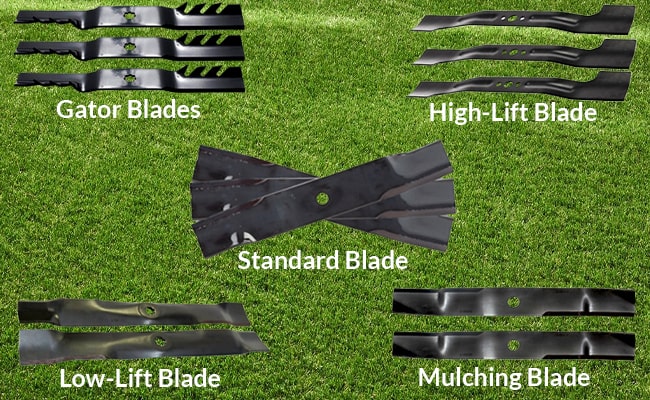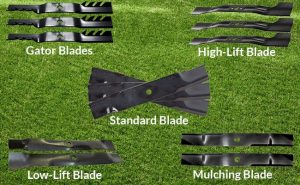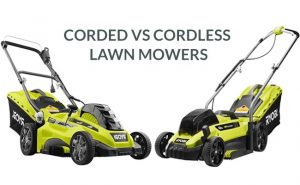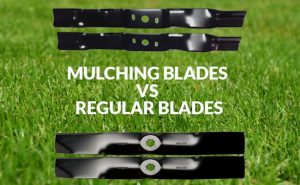Lawn mowers are essential for any house owner, who wants to keep a properly maintained yard. Just like trimming your hair, a precisely cut lawn makes your compound look fresh and more appealing to visitors.
There are different types of lawn mowers available on the market, each with various features.
Choosing the exact lawn mower that caters to your needs can be challenging. It might be foolhardy to do so without having the necessary information about them.
Each lawn mower specializes for particular terrain and landmass. The features and designs also vary in each of them.
However, the most crucial part of buying the most suitable lawn mower is having proper knowledge about the different types of lawn mower blades.

Types of Lawn Mower Blades - List with Pros and Cons
Hence, this article offers a detailed discussion on this particular feature, including the pros and cons of all types of lawn mower blades.
- Standard or medium-lift blade
- Low-lift blade
- High-lift blade
- Mulching blade
- Gator blades
1. Standard or Medium-Lift Blade
These are the type of blades that are generally used in standard lawn mowers, mostly the ones that rotate horizontally.
They are often called straight mower blades, but they tend to have a slight curve on each end.
Lawn mowers that discharge the grass debris sideways are usually equipped with blades of this kind.
Due to the slight bend at the ends of medium-lift blades, it lets a bit of air ventilate through.
This creates a sort of suction on the land, pulling up the grass so you can cut it precisely. Regular blades create only a minimal suction because the edges are not overly tilted. This only allows a small amount of air to pass through.
However, keep in mind that there are a few factors you should mull over before choosing this particular kind of blade. The most crucial factor is the type of land you are mowing on.
Although most people prefer this blade due to its high efficiency on both dry and damp surfaces, we recommend it only to use if your yard has thick patches of grass.
Standard blades can rapidly cut dense grass and send it to the bagging with ease.
On the other hand, they might not be able to remove the smaller clumps of grass from your yard, leaving you with an uneven lawn.
Therefore, it’s suggested not to use this type of blade if your yard has light grass all over.
Accordingly, medium blades might also present you with another dilemma along the way. As the blades are only slightly curved, the amount of suction created is minuscule.
The suction is enough to straighten grass for trimming but not enough to efficiently send the debris through the chute and into the bag.
As a result of this low suction power, the debris clutter up and eventually block the chute. This clog will, unfortunately, restrict the debris from being stored into the bagging.
Moreover, it might cause your lawn mower to stop working or even worse, leave unwanted trash on your precious lawn.
Pros
- Curved edges create suction
- Can easily cut dense patches of grass
- Suitable for any soil
Cons
- Often clogs the chute and restricts storage
2. Low-Lift Blade
Low-lift blades are specialized for mowing on sandy soil due to their low suction power. The edges of the blades are even less curved than the standard one.
The low suction doesn’t enable the grass to be lifted too high. This lets the grass stay fairly grounded enough to be trimmed and discharged sideways.
At the same time, the suction isn’t enough for the dust to rise with it. Hence, it settles on the ground rather than spreading around in the air you breathe.
Low-lift blades are usually 3-4 inches in size and require less power from your lawn mower. As it doesn’t strain the engine too much, your lawn mower is granted a longer lifespan.
Blades that apply more suction deteriorate much faster than low-lift blades.
The dust often settles into the deck, causing the blades to wear out before their designated expiration dates.
So, if you rely on long term durability, these blades are certainly your best choice. Low-lift blades are also suitable for their ability to work silently.
They don’t make much noise as they don’t require much power to function effectively.
Pros
- Requires less power to function
- Allows silent and effective mowing
- Suitable for sandy terrains
- Ensures long term durability
Cons
- Cannot suck the debris into the bagging
3. High-Lift Blade
You can easily distinguish High-lift blades by their certain vertical angles on the edges. This enables maximum airflow through the blades and produces a vertical suction like no other.
The fast circular motion of the blades makes the grass taut and ready for a perfect trim. Thus, it allows you to cut your lawn to utmost precision, giving it a fresh and defined finish.
High-lift blades range from 1-21 inches in length and are best suited for yards with tall grass.
The high level of suction makes sure there is no accumulation of grass in the chute, preventing blockage.
As a result, people who prefer bagging lean towards these sorts of blades.
However, this feature also makes this unsuitable for mowing on sandy terrains. Due to maximized airflow, the blades tend to suck in the sand and dust along with the grass.
As we know, dust can settle inside the deck of the lawn mower, which causes it to wear off prematurely.
Additionally, the rapid, continuous spinning of the blades require more power to create more suction. Likewise, this may damage your lawn mower earlier than expected.
Pros
- Gives the lawn a more elegant finish
- Sucks and stores the leftover debris as well
- Suitable for cutting tall grass
Cons
- Drains the engine for power
4. Mulching Blade
If you wish to replenish the soil using the grass debris, instead of just discarding it, you need a mulching blade.
You can find mulching blades in push or riding lawn mowers. They are multipurpose blades, often known as 3-in-1 blade. These blades have more distinct and curvier edges.
They also have more cutting edges than other blades which enable them to cut the grass into finer pieces and discharge them back to the ground.
Mulching blades create less suction but can still straighten the grass and trim it.
As these blades have more curves on their inner and outer surface, the trimmed grass is then transferred to the deck. There they are cut into even smaller pieces, and the innermost curves allow the particles to settle into the ground.
So, the finer the grass, the more efficiently the nutrients can be absorbed by the soil. Mulching is the most productive way to recycle unwanted debris.
If you want to make your lawn look pristine and also fertilize your garden, this blade is most suitable for you. [ Side note: to know more about mulching blade, click here. ]
However, the low suction power of these blades makes them unsuitable for cutting tall, dense grass. Dense patches of grass can’t be cut efficiently and can end up clogging the deck.
Pros
- Can be simultaneously used for three different purposes
- Has several curves on the blade which allow more exceptional cutting
- Enriches the soil with nutrients
Cons
- Dense grass can clog the deck
5. Gator Blades
Lorem ipsum dolor sit amet, consectetur adipiscing elit. Ut elit tellus, luctus nec ullamcorper mattis, pulvinar dapibus leo.
Similar to mulching blades, the gator blades are perfect for fertilizing your soil. In fact, gator blades are modified to do the job more efficiently.
The blades are specially designed to create maximum suction on the grass, which pulls it upwards.
This is because of a specific angle on the teeth of the mulching blade. It acts as a secondary blade that pulls the grass upwards in a way that all the grass can be cut precisely.
The unique angle of the gator teeth continually keeps pushing the grass towards the sharp cutting edge as the mower keeps moving. This allows the smaller pieces of grass to be cut over and over again. Even tall grasses can be cut into fine pieces by this blade effortlessly.
To get the best out of this process, you can equip a mulching kit to the blade. The mulching kit will help distribute the fine pieces of grass to settle on the earth uniformly.
The finely cut grass provides the necessary nutrients to the soil. Doing this will significantly improve the results if you’re trying to grow flowers and fruits in your yard.
You can also collect all the chopped pieces in a grass collector bag. This will save you the time and effort of cleaning the yard yourself.
It will also contribute to making your yard look admirable. So, you’ll be benefited from both ways.
Pros
- Curved teeth pull the grass upwards
- The modified blade allows more precise cuts
- Clean and environment-friendly
- Perfect for fertilizing the soil
Cons
- Cutting edges might get blunt at a rapid rate
What Type of Lawn Mower Blades is Best?
Getting the right type of lawn mower blade is important if you want your lawn to look green and healthy. The best lawn mower blades for you will depend on things like the type of grass you have, the area, the size, and the type of lawn mower you have.
If you have a small lawn and want your yard to look neat and manicured, a standard blade may be your best choice. Straight blades are great for a precise cut. It is designed to cut grass cleanly and evenly.
However, a mulching blade might be a better choice if you have a bigger yard and want to reduce the amount of time you spend maintaining it. Mulching blades are designed to cut grass and leaves into smaller pieces that can be used as fertilizer.
It’s also essential to choose a blade that is compatible with your lawn mower’s model. And remember that when it comes to lawn mower blades, there is no one-size-fits-all answer.
How Long Can Lawn Mower Blades Last For?
Depending on how you maintain it, a lawn mower blade can last anywhere from 100 to 200 hours of operation or one to three mowing seasons.
However, this can vary widely based on a number of factors. It all depends on the quality of the blade, how often you use it, what kind of grass you’re cutting, and how well you take care of it. Damage from rocks, sticks, or other things can also shorten the blade’s life. Neglecting routine maintenance like cleaning, balancing, and sharpening the blade can also reduce its useful life.
For a clean, even cut of your yard, you should keep an eye on the condition of your lawn mower’s blade and replace or sharpen it as needed.
FAQ
1. What type of steel is used in lawn mower blades?
Lawn mowers are usually fitted with blades made out of high carbon or alloy steel. This type of steel has the greater hardenability to be extremely resistant to breakage.
2. Can I use a universal blade on my lawn mower?
No, it is recommended not to replace the original blade with any other kind. It might not be suitable for cutting grass.
3. Can a broken lawn mower blade be replaced?
Lawn mowers are often considered worthless once the blade is damaged. The blade is an essential part of the mower.
However, certain lawn mower companies sell replaceable standard and mulching blades. It’s wise to buy from the same company that manufactured it.
4. How will I know when the blades become dull?
Dull blades won’t be able to trim the grass precisely. Instead, it will pull on the grass and leave jagged edges. The torn grasses will eventually change to a brownish color which you will definitely notice.
Change the blade as soon as you can because it puts extra strain on your lawn mower.
5. How often should I change my lawn mower blade?
A typical lawn mower blade lasts around 100 to 200 hours depending on the material and mowing intensity.
The duration depends on how much your lawn mower is being used. If you use it for mowing large areas, the blades will deteriorate faster. If the blade accidentally hits a rock or tree while mowing, you might need to change it too.
Otherwise, it’s wise to change them once a year, to be safe.
All in all
If you have read the article, you have the basic knowledge about the different types of lawn mower blades available. You can now pick your lawn mower that best suits your needs and preferences.
Make sure to check the blades regularly, and replace or sharpen them when necessary. Don’t mow your lawn with a dull or rusted blade as it may contaminate the grass with diseases.

Different Types Of Lawn Mower Blades Explained
Lawn mowers are essential for any house owner, who wants to keep a properly maintained yard. Just like trimming your hair, a precisely cut lawn

Top 11 Best Cheap Lawn Mowers
Are you in search of an affordable lawn mower to get that classic American picturesque lawn? If the answer is yes, then you have come

Corded Vs Cordless Lawn Mowers
Traditional gas-fueled lawn mowers are not so popular in the modern markets. Today, more and more people are choosing electric mowers because they are cheaper

Type of Oil for Lawn Mower Engine
A lawn mower is an essential tool for your lawn to keep it healthy and look beautiful in shape. That’s why proper maintenance is needed

Mulching Blades vs Regular Blades – Compared in Detail
If you have a lawn mower, you will agree with the fact that the performance of this machine is dependent on multiple standards. One of

11 Best Lawn Mower Brands of 2023
A durable lawn mower is a necessary item for people living in urban or suburban areas, especially for people who like to maintain a perfect





